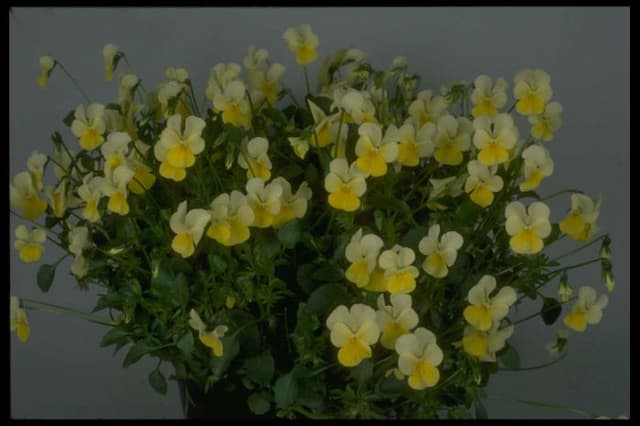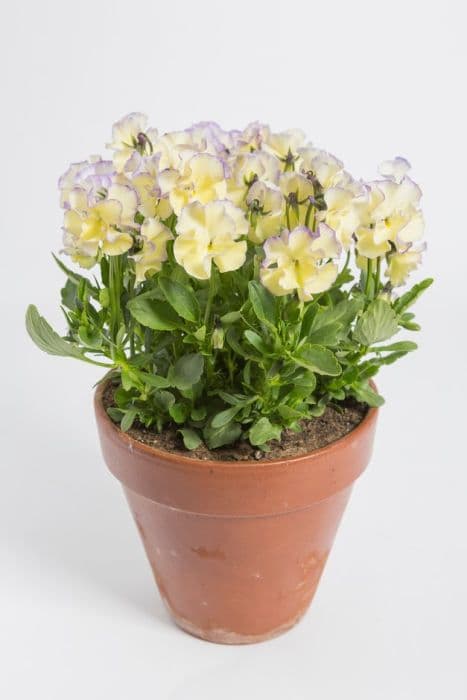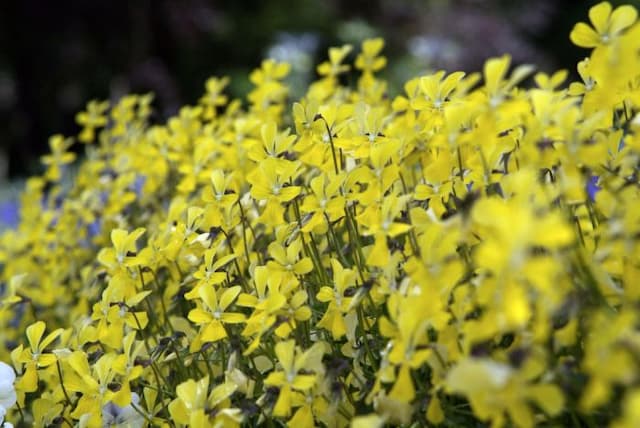Etain Violet Viola 'Etain' (Va)

ABOUT
Viola 'Etain' is a charming perennial known commonly as a pansy or violet, featuring a generous blooming habit that graces gardens with its delightful presence. This particular cultivar is admired for its beautiful flowers, which tend to be larger than those of many other violets. Each bloom presents a captivating combination of colors, with petals that are usually creamy yellow at their base, gently blending into a softer hue as they extend outward. Near the edges of the petals, a lovely shade of purple begins to infuse the yellow, creating a gradient effect that is both eye-catching and elegant. The petals themselves exhibit a velvety texture and may have delicate veining or whiskers that add to their overall intricate appearance. The center of each flower often showcases a splash of deep violet to purple, sometimes encircled by a thin outline of white or yellow. These distinctive flowers are carried above the foliage on slender stems that give the blooms a poised and upright posture, making them quite noticeable in the garden setting. In terms of foliage, Viola 'Etain' has heart-shaped leaves that are often a lush, deep green. The foliage provides a dense backdrop for the vibrant flowers, creating a rich tapestry of color and texture. The leaves may have a slightly scalloped or serrated edge, contributing to the ornamental aspect of the plant. Overall, the appearance of Viola 'Etain' is one of delicate charm and color, suitable for brightening up garden borders, containers, and as a delightful addition to cottage garden themes.
About this plant
 Names
NamesFamily
Violaceae
Synonyms
Etain Violet, Etain Viola
Common names
Viola 'Etain'
 Toxicity
ToxicityTo humans
Etain violet (Viola 'Etain') is generally considered to be non-toxic to humans. However, as with any plant material, individual sensitivity, allergies, or rare adverse reactions could occur. If a large enough quantity were ingested, especially if someone has a sensitivity to violas, mild gastrointestinal upset could potentially occur, although this is not common. There is no widespread documentation of severe toxicity from ingesting parts of the Etain violet for humans.
To pets
The Etain violet (Viola 'Etain') is also considered to be non-toxic to pets. It is not known to cause any severe symptoms of poisoning in animals commonly kept as pets such as dogs and cats. However, as with any non-food plant, ingestion may lead to gastrointestinal upset, such as vomiting or diarrhea, particularly if consumed in large quantities. Always monitor your pet and consult a veterinarian if you notice any unusual symptoms or behavior after ingestion of plant material.
 Characteristics
CharacteristicsLife cycle
Perennials
Foliage type
Semi-evergreen
Color of leaves
Green
Flower color
Yellow
Height
6-10 inches (15-25 cm)
Spread
6-12 inches (15-30 cm)
Plant type
Herb
Hardiness zones
5
Native area
Europe
Benefits
 General Benefits
General Benefits- Extended Bloom Period: The Viola 'Etain' typically flowers from early spring through fall, providing long-lasting garden color.
- Attracts Pollinators: The plant is attractive to bees and butterflies, which can help pollinate your garden.
- Versatile Landscaping: It can be used in various garden settings, including borders, rock gardens, and containers.
- Cold-Hardy: This variety of viola is known for being able to withstand colder temperatures, making it a good choice for colder climates.
- Low Maintenance: The Viola 'Etain' is relatively easy to care for, requiring minimal upkeep beyond occasional watering and deadheading.
- Drought Tolerant: Once established, it has a certain level of drought tolerance, which is beneficial in water-scarce regions.
- Aesthetic Appeal: With its attractive yellow and lavender flowers, it brings visual appeal and delicate fragrance to the garden setting.
 Medical Properties
Medical PropertiesThis plant is not used for medical purposes.
 Air-purifying Qualities
Air-purifying QualitiesThis plant is not specifically known for air purifying qualities.
 Other Uses
Other Uses- Edible Decorations: The flowers of the Viola 'Etain' can be crystallized and used as edible decorations on cakes and desserts, providing a delicate and attractive garnish.
- Natural Fabric Dye: The petals of the Viola 'Etain' can be used to create natural dyes for fabrics, imparting soft shades of purple or green, depending on the mordant used.
- Perfume Industry: The scent of Viola 'Etain' can be used in the perfume industry, although it's less common than violets, to provide a unique green-floral note to fragrances.
- Botanical Illustration: Artists and illustrators may use the Viola 'Etain' as a subject due to its unique coloration and form, contributing to botanical education and art.
- Garden Design: The Viola 'Etain' can be incorporated into moon gardens, where its light-colored flowers can glow in the moonlight and create a magical nighttime atmosphere.
- Photography: With its distinctive appearance, Viola 'Etain' can be photographed and used in stock images or plant identification apps, helping novices learn about different species.
- Pressing and Scrapbooking: The flowers of Viola 'Etain' can be pressed and preserved for use in scrapbooking and other paper crafts, providing a touch of nature to handmade projects.
- Teaching Tool: Viola 'Etain' can be used in educational settings to teach about plant life cycles, pollination, and the diversity of plant morphology.
- Floral Art: The fresh or dried flowers of Viola 'Etain' can be incorporated into floral art and installations, where their form and color can add an interesting visual element.
- Culinary Infusions: Though not typically used for their flavor, the petals of Viola 'Etain' could be infused into syrups or vinegars to add a subtle floral essence to culinary creations.
Interesting Facts
 Feng Shui
Feng ShuiThe pansy is not used in Feng Shui practice.
 Zodiac Sign Compitability
Zodiac Sign CompitabilityThe pansy is not used in astrology practice.
 Plant Symbolism
Plant Symbolism- Innocence: The Viola, commonly referred to as the Violet, often symbolizes innocence due to its delicate and unassuming appearance.
- Humble Modesty: Violets are associated with modesty because they have a habit of hiding their flowers beneath heart-shaped leaves.
- Spiritual Wisdom: Historically, violets were indicative of spiritual wisdom, inner strength, and enlightenment.
- Faithfulness: In the language of flowers, violets represent faithfulness, dedication, and loyalty in relationships.
- Mourning: Violets, particularly their purple color, also express sentiments of mourning and remembrance.
 Water
WaterThe perennial pansy, known as Viola 'Etain', thrives when watered thoroughly once every week, though this may need to be adjusted depending on climate and soil conditions. Use approximately 1 gallon of water for outdoor plants to ensure the soil is moist but not waterlogged. During hot, dry spells, increase watering frequency to prevent the soil from drying out completely. Ensure that the plant has good drainage as pansies do not like to sit in water.
 Light
LightFor perennial pansies like Viola 'Etain', it's optimal to position them in a location where they receive full sun to partial shade. These plants perform best with at least 6 hours of sunlight but appreciate some afternoon shade in hotter climates to protect them from intense heat. The dappled shade beneath a tree or a bright eastern exposure can be ideal spots for Viola 'Etain'.
 Temperature
TemperaturePerennial pansies such as Viola 'Etain' can endure a range of temperatures and are quite hardy, but they prefer cooler conditions. They flourish in temperatures between 40 and 60 degrees Fahrenheit, but can survive in temperatures as low as 20 degrees Fahrenheit and as high as 80 degrees Fahrenheit. For optimal growth, avoid placing them in conditions where temperatures exceed these thresholds for extended periods.
 Pruning
PruningPruning Viola 'Etain' encourages bushier growth and more blooms. Deadhead spent flowers regularly to prolong blooming and snip off any damaged or yellowing leaves to maintain plant health. Light pruning can be done anytime during the flowering season. The best time for more significant pruning is in the late fall or early spring to prepare the plant for the upcoming growing season.
 Cleaning
CleaningAs needed
 Soil
SoilThe best soil mix for Viola 'Etain', commonly known as the perennial Violet, should be well-draining, humus-rich, and slightly acidic to neutral with a pH of around 6.0 to 7.0. A mixture that includes peat, loamy soil, and coarse sand is often ideal.
 Repotting
RepottingPerennial Violets should be repotted every year or two to replenish nutrients in the soil and to accommodate root growth. If they are not divided regularly, they can become congested and may not flower as well.
 Humidity & Misting
Humidity & MistingPerennial Violets thrive best in moderate humidity conditions. They do not require overly high humidity levels but should be protected from extremely dry air.
 Suitable locations
Suitable locationsIndoor
Ensure bright light, cool temps, and moist soil for indoor Violets.
Outdoor
Plant in part shade, mulch well, and keep soil moist for outdoor Violets.
Hardiness zone
4-9 USDA
 Life cycle
Life cycleThe life cycle of Viola 'Etain', commonly known as Etain Violet, begins with seed germination, which occurs in a cold, moist environment as the seeds require a period of stratification to initiate growth. Upon sprouting, the seedling develops into a rosette of leaves and establishes a root system. As it matures, the plant forms distinctive heart-shaped leaves and stems elongate, leading to the budding stage. Flowering follows, showcasing the plant's large, fragrant yellow flowers edged with pale lavender, occurring primarily in spring and sporadically in fall. After pollination, usually by insects, the plant sets seed, which can be dispersed by various means, contributing to the spread of this perennial. Throughout its life, Viola 'Etain' will enter a period of dormancy in winter, resuming growth as temperatures rise in spring.
 Propogation
PropogationPropogation time
Spring-Early Summer
Viola 'Etain', commonly known as the 'Etain' Violet, is typically propagated through division, which is the most popular method for this plant. The best time to propagate 'Etain' Violets by division is in the spring or fall when the plant is not in its active flowering stage. To divide the plant, carefully lift it from the ground using a gardening fork, ensuring to keep a generous amount of soil around the roots. Gently tease apart the clumps into smaller sections, each with several shoots and a healthy root system. Replant the divisions immediately at the same depth they were growing originally, spacing them approximately 12 inches (about 30 centimeters) apart to allow room for growth. Water the newly planted divisions thoroughly to help them establish in their new location. This method of propagation not only helps to rejuvenate older clumps that may have become woody or overgrown but also increases the number of plants in your garden.









